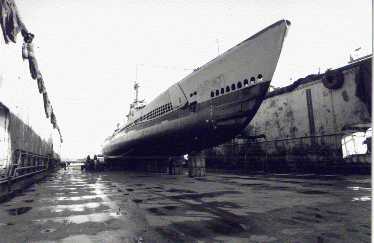USS PAMPANITO (SS-383)THE SECOND DRY DOCKING - 1993 Pampanito
was
dry docked again in 1993, our five year schedule was interrupted by an
earthquake, a massive wind storm and the problems that followed. Once we
had the submarine back on the blocks we found that almost everything went
as we had hoped. The anti-fouling coatings and the zinc anodes had performed
well and we were able to apply new coatings with only minor local repairs
to the existing system. Specifications called for two painting options
based on examination of the condition of the coatings. Option A: If we
had lost all of the anti-fouling (AF) coatings a full coat of anti-corrosive
(AC) paint had to be applied with AF coats applied while the AC coat was
still tacky so that a good bond could be obtained. Option B: If a full
coat of AF remained, new AF coats could be applied without the AC coat.
Option B was used. Pampanito
was
dry docked again in 1993, our five year schedule was interrupted by an
earthquake, a massive wind storm and the problems that followed. Once we
had the submarine back on the blocks we found that almost everything went
as we had hoped. The anti-fouling coatings and the zinc anodes had performed
well and we were able to apply new coatings with only minor local repairs
to the existing system. Specifications called for two painting options
based on examination of the condition of the coatings. Option A: If we
had lost all of the anti-fouling (AF) coatings a full coat of anti-corrosive
(AC) paint had to be applied with AF coats applied while the AC coat was
still tacky so that a good bond could be obtained. Option B: If a full
coat of AF remained, new AF coats could be applied without the AC coat.
Option B was used.
The work we had done during the previous dry docking was evaluated at this time. The zinc anodes we had placed around the underwater hull were deteriorated, as expected, and several additional anodes were added. The free flooding chain locker had remained free of accumulated material and minor damage to the coatings was repaired. The interior surfaces of the submerged superstructure were examined and found to be in good shape. It was decided that the torpedo tube shutter doors would not be removed at that time and we would address this area in the next dry docking. The shaft tapers were in good shape except for the cloth wrapping around the shafts at the struts, so it was repaired. This shipyard period was complicated by the damage to the outer shell that had been done in a severe wind storm that swept the Bay Area in 1988. The repairs required that over two hundred square feet of shell plating and several frame sections be replaced. Fortunately, the damage repairs were covered by insurance and our hull fund covered the rest of the expenses for additional work not related to the maintenance of the underwater coatings or the storm damage. The damage repairs substantially increased the time needed in the shipyard, instead of four weeks, the time of this haul out, the maintenance work could have been accomplished in five to ten days depending on the weather. The hull fund was built up to the point that the cost of all the additional work was comfortably accommodated. We now think of the fund as the preservation fund.
|
